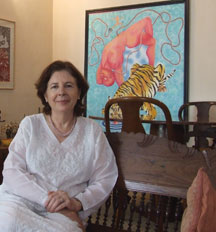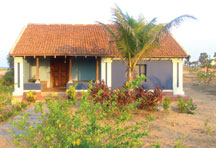India
India & I

Long after the sun set on the British Raj, India continues to lure foreigners to its shores, drawn to the land, the people, the history and its colorful culture.
Deborah Thiagarajan is an American academic, who settled in India in 1970 after marrying Karumuttu Thiagarajan, a wealthy industrialist from the Chettiar community, who died in January, and with whom she had three daughters. Deborah recalls how she gradually became the favorite daughter-in-law of his conservative in-laws.
A Ph.D. from the University of Pittsburgh, she has always been keen on architecture, conservation and heritage. India offered untold visual treasures and Thiagarajan fell in love with its textiles and crafts. She began collecting Indian treasures in earnest. During her work with the humanitarian organization CARE, she toured many southern villages, becoming familiar with local art and architecture. Gradually she realized the great need for conservation of vernacular architecture, to protect it in the face of haphazard progress and established the Madras Craft Foundation in 1984. Six years of desperate search yielded 10 acres of barren land along the coast at Muttukadu, 25 kms south of Chennai, granted on a lease by the government. “I wanted to create an awareness, to put everyday culture in an upmarket situation,” says Thiagarajan. Thus was born Dakshinachitra, a unique architectural collage of southern heritage and lifestyle museum, spread over a huge expanse of 10 acres. Eminent western architect Laurie Baker, another Indophile, designed the layout based on the map of India. It took her more than three years to identify the first building, which was finally bought, dismantled and stored for five years, before being rebuilt at the museum. More traditional homes were bought up, until the layout was complete. Small grants and her own money funded the initial development, sustained by her feverish passion for the land. In 1991 she secured a grant of $400,000, which she matched with almost $1 million and Dakshinachitra was well on its way to becoming the rare tourist spot it is today, attracting visitors from all over the world.
Many of the villagers who knocked down the first walls and dug trenches across the lane inside are today happily employed there. A huge antique textile display, kitchen wares, religious artifacts and handicrafts beguile the visitor and bemuse the art lover. Thiagarajan, who speaks fluent Tamil and loves to wear saris, plans to donate more of her own collection to the museum. Her devotion to bringing alive the living traditions of South India has inspired many locals into seeing India with new eyes. Raj de Condappa is a whirlwind of energy. He will tell you that he has traveled 200 times to Tanjore, 50 times to Khajuraho, 30 times to Ladakh, 50 times to Varanasi, 30 times to Hampi, 15 times to Amarnath, not to mention the numerous visits to Orissa, Madhya Pradesh, Karnataka and interior Tamil Nadu. He has taken three-month long trips every year to Ladakh for the past 10 years and has lived in Vietnam and France, countries he still visits. He was a popular and highly paid elite tour organizer in France and also had a bookshop and residence in Nepal for six years. He is a man inspired by Buddhism, Hinduism and by Lord Shiva in particular. Talking to the charming Condappa is like opening a Pandora’s Box – startling things come tumbling out, accompanied by delighted wicked laughter.
Condappa’s ancestor was a rich French-speaking lawyer, who was taken to Vietnam in 1882 by the French from Pondicherry, where Condappa was born. His grandfather and father were born in Vietnam and at the age of 4, Condappa, one of 8 brothers and sisters, too migrated to Vietnam. The Vietnam War brought the family back to Pondicherry, where his wealthy and stern grandma laid down the law. Condappa says he despised school, busying himself with volleyball and chasing girls. Grandma had had enough and he was packed off to study in France with 5,000 francs. The fortune, meant to last a year, was quickly spent by Condappa, who then discovered he needed a job. Traveling on a Paris subway, the realization dawned on him that he was not Vietnamese, but Indian. He ventured into the records office, where his Vietnamese language skills secured him a job as translator. The small problem of his father having to sign a form was solved by Condappa undertaking the task himself. He went to work at the National Library, where he became familiar with Jean-Paul Sartre, Michel Foucault and other famous writers of the time. Books became a lifelong passion, making him self-taught and leading to the establishment of Kailash, his publishing house. With a bookshop in Nepal, wife and son, Condappa had established himself, while also becoming a major player in the tourism industry. The rough diamond acquired a polished sheen. He returned to Pondicherry, and settled into his lovely ancestral home, a perfect showpiece, embellished with treasures from South India and the Far East. He acquired a huge tract of land by the sea in Poornankuppam, outside Pondicherry and began construction of a grandiose 10 storey home “that would withstand an earthquake!” Inspired by the garden resorts of Bali, Indonesia, the verdant Kailash Beach Resort today attracts international intellectuals, celebrities and Indian movie-makers. Condappa thus became a hotelier by accident, but a very successful one at that.
He has company in Dimitri Klein, a young Frenchman, who is a passionate hotelier, now residing in Madras. “My vision of the hospitality industry is to know and highlight local culture, to support local labor, retain the best of old culture and fuse it to modern elements, to give it new life,” Klein says. He started an agency specializing in entertainment management in France at age 19. He sold the company to Omnicom, the second largest ad network in the world, when he was 30. “I made my millions that way, enough to be able to change my way of life,” he says. His plan had been to work hard till 30, make enough money, travel, find a beautiful country, and settle down there, to conquer new ground. A world tour with his wife ended in Auroville, where his son Mitia was born. It seemed that India had chosen Klein. Neighbour Dilip Kapur, of The Hi-Design group, asked Klein to handle its marketing. At Klein’s suggestion, the company’s old colonial building in Pondicherry was turned into a hotel, the elite Dupleix, and he became a partner in the venture. Klein bought up a huge seafront acreage on the Tamilnadu-Pondicherry border, naming it The Dune. He built cottages, incorporating South Indian style and antique artifacts, as well as sturdy shacks. In December 2005. The Dune was inundated by the tsunami and Klein and his family had to flee to safety. But the Dune has rebuilt and currently boasts 37 cottages in Chettinad, Kerala and Art Deco styles, with luxurious interiors, well-landscaped gardens, lily ponds, ducks that protest at the resident pet dogs Pongo and Nash, who have the time of their lives as friendly mascots, chasing birds and being petted by children and adults alike. Another 100-acre property in Kodai Hills, called Elephant Valley, is set up as an eco tourism destination. Visitors can enjoy organic gardening, strolls in coffee plantations, trekking, horse riding, spot wild animals, or simply picnic by the river and falls, taking in the fresh mountain air. The cottages are in Klein’s signature style, emphasizing local customs. He also has plans to establish a southern chain, in Trichy, Chennai, and Tanjore, the latter on a 200-year-old property that used to be the spa of an erstwhile princess, on the banks of the Kaveri. The tsunami prodded Klein into developing social programs for affected fishermen. A foundation he founded with the French Consul General, The Children of the World, India, offers vocational training to young adults from local fisherman communities. “The boarding is financed by us and French Red Cross, free for tsunami affected children. Eleven months later we place them in fashion, hospitality and leather industries. We’ve 100% placement and are now into the third year,” says Klein proudly. With no plans to return to France, Klein hopes his children will take up Indian citizenship on adulthood.
Another Frenchman Francis Wacziarg, who came to India as a traveler in 1969, instantly fell in love with the country. He spent four months in Tamilnadu, Karnataka, Calcutta and Bombay, commuting by trains and bus. He was hooked. He set up a buying agency to source and supply beautiful Indian crafts for clients in Europe. He also began exploring the desert state of Rajasthan in partnership with Aman Nath, with whom he co-authored two books on Rajasthan. It led to Neemrana Fort Palace, their flagship heritage hotel on the Delhi-Jaipur road. A huge heritage conservation project. Neemrana has become one of the most popular heritage hotels in the country. The Neemrana Hotels group now boasts 11 “non hotels” from the Wallwood Gardens in Coimbator and The Patudi Palace in Gurgaon, to the Glasshouse on the Ganges in Rishikesh. Neemrana’s hotel Hotel de la Orient in Pondicherry is a restored, masterly landmark. Wacziarg is partial to South India. “I can read Tamil, but not speak it. I love idlis, my favorite is dosa, vadai and upma, spicy southern food. I love Kerala style seafood, fish, idiappam, aapam. I have it everyday,” he says. “The South has tremendous potential. I like the South, the food, the lifestyle, the people, a gentleness that is not there in the north. The South is able to blend tradition and modernity. In the North people are either backward as in interior Rajasthan, or they are ultra modern, having forgotten their roots. I’m happy in India, Pondy, Cochin and Matheran are the places I like most,” says this resident of Delhi, who is now an Indian citizen. Don’t you love it? Now they get to pick and choose too. |





